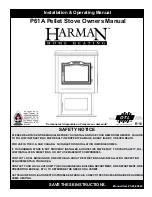
© EUROHEAT DISTRIBUTORS (H.B.S) LTD. October 2012
Instructions Part Number IN1263 Ed.A
17
Once the stove is at its operating temperature it is capable of burning cleanly
and efficiently with little or no intervention from you beyond periodic loading
of wood.
Two reasons for a stove failing to operate cleanly and efficiently make all other
reasons virtually insignificant. One is the use of wet wood, which should never
be used, and the other, which we will be discussing now, is the inappropriate
intervention by an operator failing to understand a few simple principles.
When to Put on More Wood
When the fire in the stove has become established you will find that the stove seems, initially, to consume wood
quite quickly. This is because the stove was designed to burn off the wood’s volatile matter first, leaving the
charcoal to form a hot bed above the grate. The charcoal helps maintain a constant heat output from the stove
between loading of wood and aids the rapid ignition of new loading, thus minimizing smoke emissions. The
depth to which the charcoal should be let to accumulate will depend upon the length of time you are expecting
to operate the stove for and the heat output you need. Never load more wood than can be contained safely by
the log guard.
Putting new wood on immediately the flames of the previous loading have almost extinguished will result in a
very hot stove with a deep charcoal bed capable of being controlled to burn very slowly, without staining the
glass, for many hours. If only a low heat output or limited burning time is required the charcoal will be producing
much of the heat with an occasional log being loaded for interest. Letting the bed become too small, or putting
on a new log when all the flames from a previous loading have extinguished will cause smoke as the new loading
struggles to ignite. Always add wood to the stove before flames from a previous loading have extinguished. If
there are no flames, only glowing embers, add a small amount of kindling wood and set the stove to its ignition
setting. Never put logs onto a fire without flames, they will smoulder and emit smoke.
How to Put on More Wood
Wood needs not only heat but also air to burn and putting an enormous amount of logs at one time or interlocking
them like bricks will both stifle the existing fire, causing it to cool; it will also limit the air available for the new
wood. This will result in delayed ignition of the loading and unacceptable levels of smoke emission.
Always try to keep ends of logs away from the combustion chamber walls so that gasses emanating will have
good access to air. If you are having to burn unsplit logs, they will release most of their initial gasses only from
their ends, it is important to rake embers so that the log ends are over the charcoal bed to heat the gasses to
promote rapid ignition. Avoid burning un-split logs if you can. If the logs are split it is better to put the log on the
fire bark side down because the bark will ignite rapidly when placed on the charcoal and gasses from the split
surfaces will have an unrestricted air supply.
X
X
Advanced Driving with Wood















































